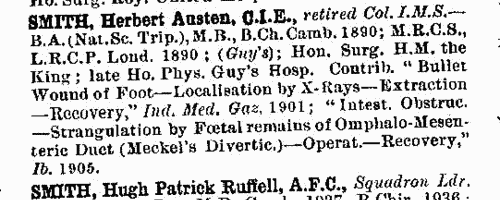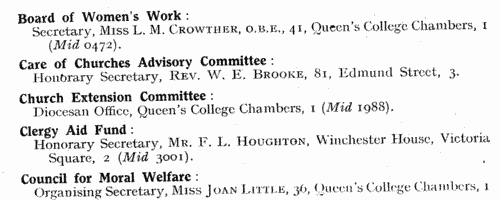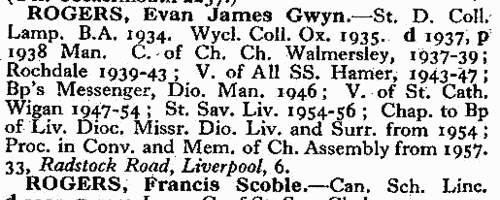Mollan Surname Ancestry ResultsOur indexes 1000-1999 include entries for the spelling 'mollan'. In the period you have requested, we have the following 29 records (displaying 21 to 29): Single Surname Subscription | | | Buying all 29 results of this search individually would cost £140.00. But you can have free access to all 29 records for a year, to view, to save and print, for £100. Save £40.00. More... |
These sample scans are from the original record. You will get scans of the full pages or articles where the surname you searched for has been found. Your web browser may prevent the sample windows from opening; in this case please change your browser settings to allow pop-up windows from this site. Anglican clergy
(1930)
Crockford's Clerical Directory listed all Anglican clergy in the British Isles, India, the colonies, Europe, Asia and South America. The 59th annual issue, for 1930, is based on returns from all the individuals listed. The details given are: name (surname first, in capitals) in bold, prefixed by an asterisk in the case of university electors, and by a dagger whether the return had not been made, or it had been imperfectly filled up; name of theological college and/or university, and degrees, with years; a bold d followed by year and diocese signifies date of ordination as deacon and by which bishop; then a bold p, similarly for ordination as priest; posts (C: curate; I: incumbent; V; vicar; R: rector) with parishes and years; address; telephone number; and lists of books &c. where appropriate. In the case of the man then holding an English, Irish, Scottish or Welsh benefice, additional details are given - a bold P signifies the patron of the advowson; then the income, with items such as Q. A. B. (Queen Anne's Bounty), Eccles(iastical) Comm(issioners), Fees, e. o. (Easter Offerings), Pew Rents, T(ithe) R(ent) C(harge), Gl(ebe), &c.MOLLAN. Cost: £4.00.  | Sample scan, click to enlarge

| Boys at University College School
(1901-1931)
In 1830 a school was set up adjoining the University and College of London on Gower Street; the school was enlarged from 1860 to 1876, and then removed to Frognal in 1907. In 1931 this register was published, listing all boys entering the school from Christmas term of 1859 to the summer entrants of 1931. The dates are abbreviated (98-01 = 1898-1901, &c.), each session being reckoned as beginning in September of one year and ending in the July of the next; the date of joining the school is indicated by the former, although it may fall in the latter, but the date of leaving by the latter, although it may fall in the former. Thus, if a boy came at any time during the Session 1863-64 and left any time during 1868-69, his date would be given 1863-69. The boys are listed alphabetically by surname, and then chronologically under each surname, full name being given where known. An asterisk * indicates that that particular boy lost his life in the Great War: in these cases, rank and regiment have been given where possible. Addresses as of 1931 are given where known. Italics in christian names or initials indicate that that particular boy was known, in 1931, to be dead. (a) (b) &c placed before christian names indicates brothers. In some cases occupation in later life is shown (A, artist; B, barrister; C A, chartered accountant; Ch, chemist; E, engineer; H C S, home civil service; I C S, Indian civil service; Med, physician or surgeon; M S E, member of the Stock Exchange; Mus, musician; Rev, minister of religion; S, solicitor). This is the index to those boys who were at the school in the period 1901 to 1931.MOLLAN. Cost: £4.00.  | Sample scan, click to enlarge

| Officers of the British Army and of the Indian Army
(1934)
The Half-Yearly Army List, issued By Authority, 30 June 1934, lists all officers in active service at that date, and this list was evidence of the status and rank of the officers contained in it. The entries are set out as a gradation list, by rank, from field-marshals to lieutenants, and within each rank in order of seniority at that rank. Each officer's name (surname first, in capitals, then christian name and present rank (with date of achieving that rank) and regiment &c. are given, for convenience, in bold type, with any national decorations in italics after the name. Each entry also gives date of birth, number of days service in the ranks, dates of service in each rank of officer, particular offices and postings (with dates) and, where appropriate, a summary of war service, and medals. For all but the oldest of the officers then serving, the war service details are for the Great War (1914-1921), and campaigns in Iraq, Waziristan, and the North West Frontier of India. War services are not given in this edition for Indian Army officers, except in that their entries are preceded by a crossed swords symbol where they have seen war service in a theatre of war overseas. After the gradation list of officers, there is a section for the Royal Malta Artillery; and then (pages 1152 to 1185) warrant officers - staff or garrison serjeant-majors, educational serjeant-majors, serjeant-major (physical training and educational) instructors, regimental serjeant-majors (and corporal-majors, farrier-serjeant majors, master gunners, assistant instructors in gunnery, experimental serjeant-majors, artillery clerks, farrier-serjeant-majors, artificer serjeant-majors, clerks of works, mechanist, superintending clerks, draughtsmen, 1st class staff serjeant-majors, transport, supply, conductors, sub-conductors, armourers, armament artificers, headmasters, schoolmasters, marine gunners, and bandmasters. The section for the Royal Army Chaplains' Department lists all chaplains (1st to 3rd class); and that for Queen Alexandra's Imperial Military Nursing Service has all matrons, sisters and staff nurses. The lists of nurses do not give date of birth: all are unmarried. The book concludes with the Yeomen of the Guard, the Honourable Company of Gentlemen-at-Arms, and the King's Body Guard for Scotland, in each case giving name (surname and initials, not christian names), honours, name of late regiment, and date of appointment.
MOLLAN. Cost: £4.00.  | Sample scan, click to enlarge

| London Telephone Subscribers
(1939)
The London telephone directory lists subscribers alphabetically by surname and then by christian name or initials, with their postal address and telephone number. This is the L to Z directory issued in May 1939, but also contains some names from earlier in the alphabet, for instance in the separate section for midwives. The London telephone districts comprised not only the city centre, but also the very extensive suburbs in the Home Counties (Essex, Kent, Surrey and Middlesex).MOLLAN. Cost: £4.00.  | Sample scan, click to enlarge

| Doctors in Military Service
(1948)
The Medical Directory was split into several sections. This section covered medical practitioners in the Navy, the Army, the Indian Army and the Royal Air Force. The doctor's name is given first, in bold, surname first, in capitals; then current address. Next are the qualifications; the italic abbreviations in parentheses following the qualifications indicate the medical school at which they were gained. Then there is a list of posts and honours within the profession, starting with those then current; previous posts are preceded by the word 'late'. Finally, brief details are given of any publications.MOLLAN. Cost: £2.00.  | Sample scan, click to enlarge

| Prominent Inhabitants of Birmingham
(1949)
The Birmingham Post Year Book and Who's Who is an annual publication seeking to give comprehensive information about the city's organizations and its eminent residents. The Year Book has separate sections dealing with the City Council; the Municipal Elections; Municipal Departments; The High Court of Justice; Members of Parliament for the City; Political Associations; Government Departments; Trade and Industry; Birmingham Consular Association; Banks and Branches; Birmingham Stock Exchange; Restaurants and Cafes; Health; Churches and Religious Congregations; Freemasons; Education; Child Care; Youth; Cultural Activities; British Broadcasting Corporation; Sports and Pastimes; Philanthropic and Kindred Institutions; County and Kindred Societies; International Societies; United Nations Association; Clubs; Transport; The Forces; Toc H.; Royal Antediluvian Order of Buffaloes; Electricity and Gas Boards; Law List; Chartered Accountants; Incorporated Accountants; Certified and Corporate Accountants; Chartered Secretaries; Surveyors, Auctioneers, Land Agents and Valuers; Architects; Civil Engineers; Mechanical Engineers; Electrical Engineers; and Old Boys' Associations. For most organizations, names and addresses of secretaries and other officers are given. Full lists of professional people are given in their sections, with addresses. Then there is the Who's Who in Birmingham, which (with an In Memoriam section for those who had died in the last year) usually gives full name (surname first, in capitals, in bold), date and place of birth (and often father's name), if married the year and name of spouse (and sometimes father's name); numbers of sons and daughters; a brief description of career, recreations, and current address.MOLLAN. Cost: £6.00.  | Sample scan, click to enlarge

| Chemists
(1950)
The Royal Institute of Chemistry was founded in 1877, and was open only to British subjects (and also, in due course, to citizens of the newly-created Republic of Ireland). Associates of the institute (A. R. I. C.) qualified either by studying chemistry, physics, mathematics and an optional science for the institute's examination (which insisted on a high standard of practical laboratory efficiency); or by obtaining good honours degrees or equivalent qualifications, with chemistry as principal subject, and having undergone training in allied sciences. Associates of at least three years' standing could then be admitted to the Fellowship (F. R. I. C.) either by taking a further examination in a special branch of chemistry, or by submitting the results of work or evidence of experience sufficient to justify the Council in granting exemption from such further examination. This register of fellows and associates, correct to 31 August 1950, contains 11,545 names, arranged alphabetically, surname first (in capitals), with qualifications, current address, telephone number, and (in italics) a brief description of present post in the chemical industry. Finally, year of admission as associate (A.) (and, where appropriate, fellow (F.) is given on the right-hand side. With this may appear the notation (x) for a fellow of the Chemical Society, (y) for a member of the Society of Chemical Industry, or (z) for a joint subscriber to all three chartered bodies.MOLLAN. Cost: £4.00.  | Sample scan, click to enlarge

| Anglican clergy
(1957)
Crockford's Clerical Directory listed all Anglican clergy in the British Isles, India, Africa, Canada, the West Indies, Europe, Australasia and South America. The 77th issue, for 1957-58, is based on returns from all the individuals listed, and was deemed correct as of 30 September 1957. The details given are: name (surname first, in capitals) in bold; name of theological college and/or university, and degrees, with years; a bold d followed by year and diocese signifies date of ordination as deacon and by which bishop; then a bold p, similarly for ordination as priest; posts (C: curate; I: incumbent; V; vicar; R: rector) with parishes and years; address; telephone number; and lists of books &c. where appropriate. In the case of the man then holding an English, Irish, Scottish or Welsh benefice, additional details are given - a bold P signifies the patron of the advowson; then the income, with items such as Q. A. B. (Queen Anne's Bounty), Eccles(iastical) Comm(issioners), Fees, e. o. (Easter Offerings), Pew Rents, T(ithe) R(ent) C(harge), Gl(ebe), &c.MOLLAN. Cost: £4.00.  | Sample scan, click to enlarge

| Flight Lieutenants: General Duties Branch
(1957)
The Air Force List for 1957 contains gradation lists for all serving officers, corrected, generally, up to the appointments and promotions gazetted 2 April 1957. The officers are listed by branch, rank, and date of seniority; the names are given surname first, initials, decorations, and various sets of initials relating to their particular qualifications or expertise. A double-headed dagger before the name denotes a permanent direct commission; a dagger a national service commission; an asterisk some other non-permanent commission. The main abbreviations are: a. a., qualified at Army Long Gunnery Staff Course (A. A.); c. f. s., qualified flying instructor (with an asterisk if A1 category, without, A2); I, 1st class interpreter; i, 2nd class interpreter; i. d. c., completed a course at the Imperial Defence College; j. s. s. c., completed a course at the Joint Service Staff College; P, on probation; p. f. c., graduate of Pilot Flying College; p. s. a., graduate of R. A. F. Staff College; p. s. c., graduate of Military Staff College; q. s., R. A. F. graduate of the Military or Naval Staff College; Sp, medical or dental specialist; t. p., graduate of Empire Test Pilots' School; Z, qualified in A. I. S. Inspection Duties. In the Ground Section lists a further set of abbreviations, in bold in brackets in front of the names, identifies certain specialities - AcC, aircraft control; Bal, balloon; FC, fighter control; Ph, photographic; PhI, photographic interpretation; RS, radar supervisor.MOLLAN. Cost: £4.00.  | Sample scan, click to enlarge

|
Research your ancestry, family history, genealogy and one-name study by direct access to original records and archives indexed by surname.
|











